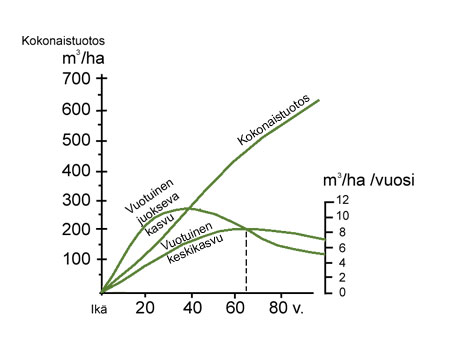
The volume growth is always indicated by square meters per hectare. The growth can be indicated either with or without bark. However the growth is calculated from the stem to the treetop, not by starting from the roots.
Growth terms:
Total output is the total amount of volume growth from since the forest was born until the point of calculation.
Total annual growth is the amount of annual volume growth from one year to the next.
The average annual growth is the total growth divided by the age of the tree.
Value increment
The graph of ongoing growth intersects the graph of average growth in its peak. The timing of thinning varies depending on the species of the wood. They do however have something in common; they are all done when the trees have reached their maximum height in growth. If all the produced wood would cost the same regardless of the robustness this would be the time for logging the whole forest. However, as the robustness of the trees increase, so does the monetary value of the forest. Thus the growth of value doesn’t stop when the growth of volume has peaked.
Thinning
People are mainly interested in the frame of the tree but from a biological stand point, the treetop is the most important part of the tree. This is because the tree mass is determined by the treetops and what condition they are in. Only part of the conifer trees and deciduous trees are a part of construction in an overly dense forest. This active mass is formed from the treetops of the predominant trees. In thinning where the predominant trees are most wanted, the active treetop mass doesn’t decrease much. Rehabilitation happens fast due to the increased growth areas.
Thinning does not affect the height growth of predominant trees. It makes them more robust. The volume growth of a forest can’t be increased with thinning but it can be guided to certain trees. In a nut shell; thinning is basically taking care of the treetops on predominant trees.
Source Stig Nordman